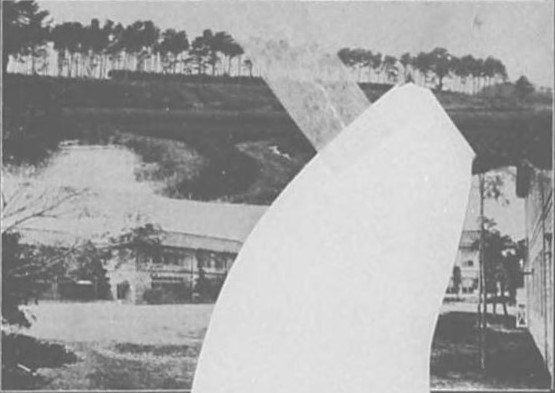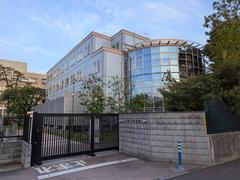
Takachiho University Tokyo Visiting Guide: History, Tickets, and Tips
Date: 14/06/2025
Introduction
Takachiho University, located in Tokyo’s lively Suginami ward, is a distinguished institution with a legacy that spans over a century. Founded in 1903 during Japan’s transformative Meiji era, the university has grown from a commercial school into a renowned center for commerce, business administration, and human sciences. Its campus blends modern facilities, lush green spaces, and proximity to culturally significant sites like Takachiho Shrine and Omiya-Hachimangu Shrine, making it a rewarding destination for both academic visitors and cultural explorers (Takachiho University Historical Guide, Suginami Tourism Guide).
This detailed guide provides all the essential information for visiting Takachiho University and its surrounding landmarks, including historical background, campus highlights, access details, nearby attractions, and tips for an enriching visit. Additional sections cover the adjacent Takachiho Shrine in Tokyo and the mythologically significant Takachiho Shrine in Miyazaki Prefecture, helping travelers experience the full depth of cultural and spiritual heritage connected to this area (Takachiho University Campus Tour, Takachiho Shrine Visitor Guide).
Table of Contents
- Introduction
- Historical Background
- Visiting Takachiho University
- Cultural and Historical Significance
- Takachiho Shrine (Tokyo)
- Takachiho University Campus Tour
- Takachiho Shrine (Miyazaki Prefecture)
- Frequently Asked Questions (FAQ)
- Conclusion and Final Tips
- Sources and Official Links
Historical Background
Founding and Early Development
Takachiho University was established in 1903 amid Japan’s modernization drive, initially as a commercial school designed to broaden educational access beyond the elite. This development paralleled nationwide efforts to standardize and modernize education, such as the introduction of the Gakusei (School System) in 1872. While higher education remained exclusive for several decades, reforms like the College Ordinance of 1918 enabled professional schools to gain university status, laying the groundwork for institutions like Takachiho (Facts and Details).
Postwar Reforms and University Status
After World War II, sweeping reforms under Allied occupation led to the adoption of the four-year college system. In 1950, Takachiho’s predecessor officially became Takachiho University, marking a new era of academic expansion and societal contribution (Wiki Gateway).
Academic Focus and Institutional Identity
Takachiho University is recognized for its dedication to commerce and business studies. Nicknamed the “Edo University of Commerce,” it offers programs in Commerce, Business Administration, and Human Sciences, supporting Japan’s evolving economy and nurturing future leaders in industry and public service (Study in Japan).
Visiting Takachiho University
Visiting Hours and Access
- Hours: Open to visitors on weekdays from 9:00 AM to 5:00 PM. Confirm hours and event schedules via the official website before visiting.
- Admission: Free campus entry; ticketed access may apply for select facilities or special events.
Getting There
- Address: Omiya 2-19-1, Suginami, Tokyo 168-8508, Japan.
- Public Transport: Closest stations are Ogikubo and Koenji (JR Chuo Line) and Eifukucho Station (Keio Inokashira Line), with convenient bus and taxi connections.
Nearby Attractions
- Omiya-Hachimangu Shrine: Historic and tranquil shrine neighboring the campus.
- Zenpukuji-river Green Belt & Wadabori Park: Idyllic green areas for relaxation and scenic walks.
- Kichijoji and Koenji Districts: Explore Tokyo’s vibrant neighborhoods, known for their culture, vintage shops, and festivals.
Campus Highlights
The campus juxtaposes modern architecture with inviting green spaces. Seasonal blooms—cherry blossoms in spring and colorful foliage in autumn—make it especially picturesque. Notable features include the main gate stone monument, central courtyards, and accessible pathways.
Special Events and Tours
Open campus days, student festivals (notably in autumn), and cultural events frequently welcome visitors. Guided campus tours are available by appointment, offering deeper insight into the university’s history and student life.
Cultural and Historical Significance
Takachiho University is more than an academic institution—it is a symbol of Japan’s educational progress and cultural resilience. Its location beside historic shrines and green spaces highlights a balanced commitment to tradition, innovation, and community.
Takachiho Shrine (Tokyo): Overview and Visiting Information
Overview and Significance
Adjacent to the university, Takachiho Shrine is a revered Shinto site reflecting Suginami’s rich cultural heritage. Traditional architecture and a martial arts hall (recognized as a tangible cultural asset) make it a meaningful stop for visitors seeking spiritual and historical depth.
Visiting Details and Tips
- Hours: Open from dawn (typically 6:00 AM) until dusk (usually 5:00 PM).
- Admission: Free. Donations are appreciated.
- Access: Walkable from the university and accessible by public transit.
- Photography: Allowed in most areas; be mindful and respectful during ceremonies.
- Events: Public festivals and ceremonies are held throughout the year. Check local tourism resources for details.
Takachiho University Campus Tour
Architecture and Layout
The campus is compact and pedestrian-friendly, featuring a harmonious mix of academic buildings, central plazas, and garden spaces. The main gate and surrounding courtyards serve as gathering points and event venues.
Academic and Cultural Facilities
Takachiho University is known for its modern lecture halls, cutting-edge seminar rooms, well-stocked library (with over 200,000 volumes), and specialized research centers. An on-campus museum and commemorative displays celebrate the university’s historical milestones.
Student Life and Green Spaces
The student union offers dining, lounges, and convenience stores. Outdoor facilities include sports fields, tennis courts, and a gymnasium. Traditional gardens and a pond provide tranquil spots for relaxation and seasonal hanami picnics.
Art Installations and Monuments
A bronze statue of the founder, contemporary sculptures, and commemorative plaques enrich the campus environment. Descriptions are provided in Japanese and English for international visitors.
Accessibility and Amenities
- Accessibility: Wheelchair-friendly paths and accessible restrooms.
- Visitor Support: Multilingual information desks, free Wi-Fi in public spaces, and clear bilingual signage.
- Transport: Eifukucho Station (Keio Inokashira Line) is a 10-minute walk; limited parking available.
Events and Practical Tips
- Best Seasons: Spring (March–April) and autumn (October–November).
- Dress Code: Casual, comfortable attire and walking shoes.
- Tours: Book in advance through the visitor center.
- Dining: Campus cafeteria and nearby eateries offer diverse menus, including vegetarian and halal options.
- Souvenirs: University merchandise is sold at the bookstore.
Takachiho Shrine (Miyazaki Prefecture): Visiting Information and Cultural Experience
Introduction and Mythological Background
Located in scenic Takachiho, Miyazaki Prefecture, this shrine is central to Japanese mythology, marking the legendary site associated with the sun goddess Amaterasu. The shrine is a living testament to spiritual tradition and ancient folklore.
Visiting and Access Information
- Hours: Open daily from 7:00 AM to 6:00 PM (extended hours during special events).
- Admission: Free; ticketed entry for select ceremonies such as the Takachiho Kagura dance (October–March).
- Location: Accessible by bus from Takachiho Station; approximately 3.5 hours from Tokyo by train and bus.
- Facilities: Paved paths and assistance for visitors with mobility needs.
Tips and Nearby Attractions
- Best Times: Spring and autumn for mild weather and scenic beauty.
- Local Cuisine: Enjoy regional specialties at local eateries.
- Nearby: Takachiho Gorge—famed for its dramatic landscapes and boat rides.
Additional Information
- Tours: English and Japanese guided tours can be arranged through the local tourist office.
- Photography: Allowed outdoors; restricted during some ceremonies.
- Parking: Available near the shrine.
For more details and event schedules, visit the Takachiho Shrine Official Site.
Frequently Asked Questions (FAQ)
Q: Is there an entrance fee for Takachiho University?
A: No, entry is free. Some events or facilities may require tickets.
Q: Are guided tours available?
A: Yes, by appointment via the university’s visitor center.
Q: Is the campus accessible for visitors with disabilities?
A: Yes, the campus is wheelchair-friendly and offers accessible amenities.
Q: What’s the best way to reach the university?
A: Public transportation is recommended; Eifukucho Station (Keio Inokashira Line) is a 10-minute walk.
Q: Can I visit both Takachiho University and the nearby shrine in one day?
A: Yes, the locations are adjacent and can be comfortably explored together.
Conclusion and Final Tips
Takachiho University offers a unique blend of academic history, cultural heritage, and natural beauty. Whether you’re interested in Japan’s educational evolution, student life, or the tranquil surroundings of historic shrines, a visit promises insight and inspiration. For the fullest experience, plan your trip in spring or autumn, leverage public transport, and consult official channels for event updates.
For more information, virtual tours, and personalized travel support, visit the Official Takachiho University Website and consider using travel apps like Audiala.
Summary of Key Points and Recommendations
- Takachiho University: Founded in 1903, renowned for commerce and business studies, accessible campus with modern and traditional features.
- Takachiho Shrine (Tokyo): Historic Shinto site adjacent to the university, open daily, free entry.
- Takachiho Shrine (Miyazaki Prefecture): Mythologically significant, beautiful natural setting, free entry, ticketed performances in season.
- Optimal Visit Times: Spring and autumn for festivals and scenic beauty.
- Travel Tips: Use public transport, reserve tours, check event calendars, and explore nearby attractions for a comprehensive experience.
Sources and Official Links
- Facts and Details: Takachiho University – Historical and Visitor’s Guide
- Wiki Gateway: Takachiho University Wikipedia Entry
- Study in Japan: Takachiho University Campus Tour
- Takachiho Shrine Official Site (Miyazaki)
- Takachiho University Official Website
- Tokyo Tourism Information
- Keio Inokashira Line Transit Info






























































































































































































































